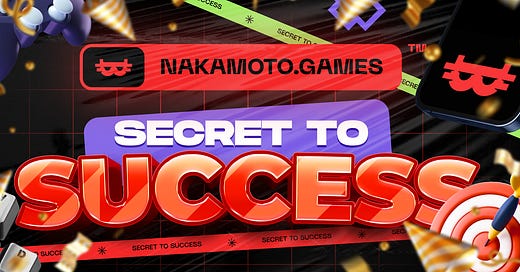The Secret to Nakamoto Games’ Rapid Development: Optimal OKRs
Effective goal setting, leadership, and communication through OKRs are critical to our success
In the space of just two years, Nakamoto Games has built a flourishing Web3 Gaming Ecosystem. We have produced a blockchain platform packed with an endless selection of Web3 games and dozens of ways for users to earn.
How have we come so far in such a short space of time? The secret is our OKR strategy. OKR stands for Objectives and Key Results. It's a dynamic goal-setting and leadership tool that helps our team achieve milestones with clarity and purpose.
To put OKRs into place, we first define our long-term objectives and then break them down into short-term goals. Each goal is assigned a set of key results with specific and measurable outcomes. The team monitors and tracks progress regularly and adjusts to stay on course toward objectives.
Adjusting and remaining adaptive is critical in an industry as dynamic as Web3 gaming. OKRs are more than just KPIs (Key Performance Indicators). They’re measures for change, whereas KPIs are measures of health. Our OKRs aim for change above maintaining the status quo.
OKRs are a proven system implemented by some of the biggest tech companies in the world. Google, Amazon, LinkedIn, and Twitter user OKRs to boost goal alignment, accountability, and transparency and foster continuous improvement. OKRs help keep order in companies with large teams with many moving parts.
At Nakamoto Games, we have several teams collaborating to achieve complex tasks. From game development to smart contracts to frontend design, OKRs ensure everybody knows their duties and stays informed on the developments within other departments.
Fig 1. Example of Nakamoto Games OKR for Smart contract teams
Nakamoto Games has OKRs for everything from game testing and development to security to Web3 research and innovation. In addition to technical objectives, we have established personal goals such as enhancing skills, prioritizing physical well-being, and improving teamwork.
This way, each individual has goals to strive for while also contributing to the team's success. Here are some examples:
Objective #1 - Improving the testing process
Create thorough test cases that cover all avenues. This objective ensures the quality of our product by detecting and fixing any issues before releasing it to the market.
Objective #2 - Enhancing production quality for all systems
We set a goal of having fewer than 5 high-priority bugs, 10 medium-priority bugs, and 15 low-priority bugs. This objective helps maintain a high-quality product by ensuring that bugs are promptly addressed.
Objective #3 - Improve communication to increase QA efficiency
Providing and integrating cross-department feedback to improve the results. This objective helps us streamline our processes and promote collaboration between the QA and development teams.
Objective #4 - Promote self-improvement and knowledge-sharing among team members
Share new knowledge weekly, review coding with team members every two weeks, and improve game development skills every two weeks. This objective keeps the entire team up-to-date with the latest developments in their field while continuously improving their skills.
This is a small sample of the standards we set and the methods we use to achieve them. We reach our goals time and time again through good communication, dedication, and accountability.
For our team, OKRs provide the perfect formula for remaining adaptive, efficient, and effective in an ever-changing industry. Our lightning-fast progress is a testament to this.
We’re not slowing down, either. We have some wonderful things in the works for 2023. Keep up-to-date as we implement our development strategies to bring you lucrative, innovative, and fun new games and services.




